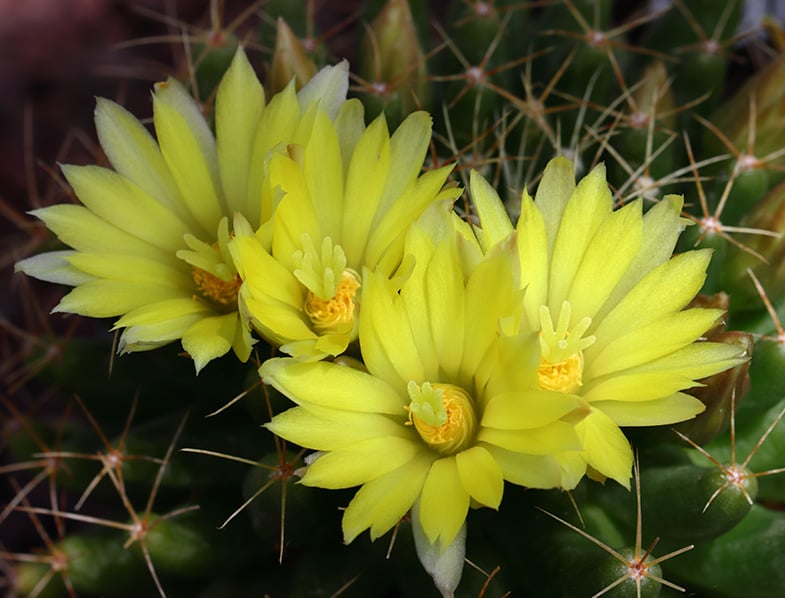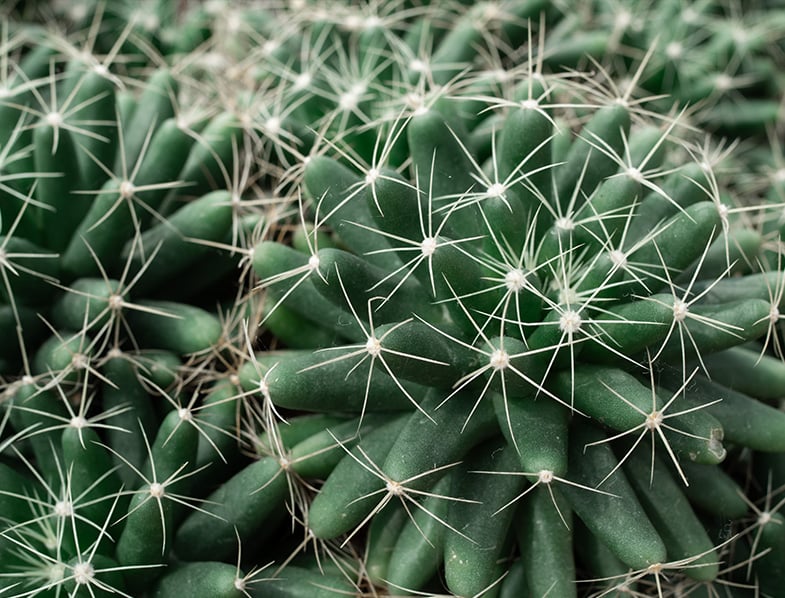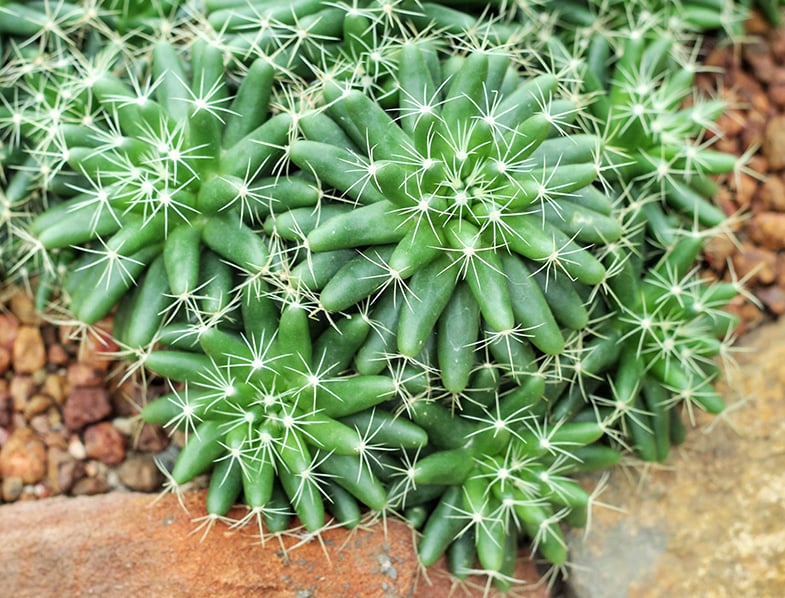Are you looking for a unique, eye-catching cactus that can improve your overall home design? Well, why not? There is always room for more! And as its name suggests, this cactus will be the big mamma of your other cacti babies.
Mammillaria Longimamma, commonly referred to as the Finger Cactus, Nipple Cactus, Pineapple Cactus, or Finger Mound, is a species of flowering cacti in the Cactaceae family. This beauty is native to Texas and several regions of Mexico, such as Hidalgo and Queretaro.
Finger cacti can be grown as ornamental houseplants by any type of gardener as long as the environmental conditions are similar to those from their natural habitat. However, they will show the best results in the desert, subtropical, or Mediterranean climates.
Many gardeners appreciate these low-maintenance perennials for their peculiar appearance and huge flowers. You will see them mostly indoors placed on desks, tables, or shelves and planted in pots. Make sure you choose a cute-looking pot that will complement your interior design!
About Finger Cactus
- Mammillaria Longimamma cacti can be found growing in volcanic soils or on limestone. They generally appear at 3281 to 6566 feet (1000-2000 m) above sea level.
- In their natural habitat, they are protected by low shrubs and sparse vegetation, sharing the territory with other species of cacti.
- Thanks to their similar environmental requirements, these cacti make for an excellent companion to Agaves, Opuntias, a few Ferocactus species, and many succulents.
- The curious specific epithet “longimamma” is the Latin for “long nipple”. This name refers to their long and weird-looking roots called tubercles.
- To grow healthy and happy, Finger cacti prefer locations with partial to full shade. They can be grown in bright and indirect light only if you live in a cooler region.
- They enjoy average room temperatures that are maintained above 50 °F (10 °C). Although they are a little frost hardy, it is better to keep them inside in winter.
- These cacti will benefit from regular watering and even fertilizing during their active growing season. They are best planted in neutral to acidic soil that has good drainage.
- Finger cacti are pretty versatile species that can be propagated through different methods including offset cuttings, seed sowing, and tubercles removal.
- Generally pest-free, your Finger cacti will be only occasionally bothered by spider mites. The infected parts can be treated with a cotton pad dipped in rubbing alcohol.
- They have no toxic effects reported and do not present a poisonous latex either. You can grow these cacti safely around pets and children, but they will sting anyone who gets too close to them.

Finger Cactus Features: An Overview
- They belong to one of the largest genera known as Mammillaria. This genus contains about 200 species and varieties with many popular ornamental houseplants cultivated around the world.
- Finger cacti are solitary at first and start to cluster up at a very young age. The dense clustering can reach about 6 inches (15 cm) or more in width.
- Their roots are very long, finger-like, and flaccid tubercles. They are soft to the touch and offer the plants good stability.
- The spherical-shaped and lime green stems grow between 6 and 8 inches (15-20 cm) in height and up to 5 inches (12 cm) in diameter. They lack latex.
- In general, these cacti contain from 10 to 30 succulent branches. However, some plants may be more vigorous and show up to 50 branches.
- Finger cacti exhibit both radial and central spines, although some specimens like var. uberiformis may not present a central spine at all. They usually have one central spine of one inch (2.5 cm) long and many white-yellowish or brown radial spines.
- During the summer, from May to July, their blooming is very abundant. Their flowers are followed by yellowish-green fruits.
- They produce many gorgeous trumpet-shaped flowers that measure up to 2.5 inches (6 cm) in diameter and come with bright yellow petals and an orange-reddish base.
Growing Finger Cactus
Finger cacti are quite different than other species of cacti. Their environmental requirements are more similar to those of smooth succulents, but this will not be a major problem for you. With lots of love and attention to details, these little cacti will be your companion for a long time!
In the wild, finger cacti are protected from bright and direct light because they usually grow under shrubs. They will do well in a semi-shaded location or even in complete shade all-year-round. With a low tolerance to harsh sunlight, it is better to keep them indoors or filter the light using sheer curtains. If you live in a region with cooler climates, you can leave them in a somehow sunny place where they can receive plenty of bright and indirect light.
Finger cacti thrive in mid-cool to slightly warm temperatures above 50 °F (10 °C). They are quite tolerant of freezing temperatures that drop to 22 °F (-5 °C), but not for long periods. During the winter, it is suggested you bring your cacti inside and place them in a warm room. Make sure you keep them away from cold drafts at all costs.

Planting Finger Cacti
In spring or summer, plant your Finger cacti in a pot that has drainage holes at the bottom and is filled with rich well-draining cactus potting mix. You can improve drainage by adding a layer of pebbles, lava rocks, or gravel under the potting soil. Moreover, a touch of 70% to 80% coarse sand, perlite, or pumice in the soil will give your cacti the time of their life.
Finger cacti will benefit from regular fertilizing during their active growing and blooming period. From early spring to late fall, feed your plants with a diluted fertilizer that is high in potassium once every two weeks.
They grow at a pretty slow pace, so you will not need to worry about repotting them too often. Typically, Finger cacti need a new pot after 2-4 years when they start to outgrow their current one. Look for a slightly larger pot and fill it with fresh potting mix. Take out your cacti from their current pots, remove any extra old soil, and transplant them into their new growing medium. Wait about one or two weeks before starting to water them again.
Watering Finger Cactus
Like most cacti, these adorable specimens have no high demands regarding watering. Finger cacti will need some extra attention only during their active growing period. They are drought-tolerant plants that prefer a forgetful owner to an overly-caring one, so you must leave the worries behind right now!
Make sure you always check the soil in-between waterings and provide your Finger cacti with water only when it has dried out completely. From early spring to late summer, these cacti may need watering once a week. However, the frequency of watering may vary depending on the climate, potting soil, and humidity. Once the temperatures are cooler, you can skip watering.
When it comes to humidity, Finger cacti show the best results in a dry environment. If the air around your plants is too humid, go buy a dehumidifier and place it near them.

Propagating the Finger Cactus
Time for new little fingers to join the club! With their easy-going style and so many methods to choose from, it will be a shame not to propagate your Finger cacti. The process is simple and generally does not take too much time, but you might want to wear some protective gloves. These cacti are quite spiny and can hurt your skin if you’re not careful.
The easiest way to propagate your Finger cacti is through seeds. They can be collected from the plants’ fruits and simply planted in suitable potting soil. The pot must be covered with plastic wrap to maintain a humid medium and placed in a warm, slightly shaded location. With proper care and regular watering, the seeds will germinate in a few months. Once the roots have developed, the seedlings can be transplanted to their individual pots.
If you want faster results, Finger cacti can also be propagated by offsets that grow sporadically around the mother plant. This method can be applied to a specimen that has reached maturity and gained a decent size. The cuttings should be taken with a sharp and sterilized knife from early spring to late summer.
Place the offsets on a paper towel in a shaded area for a few days to allow them to callous. Once the cuttings have hardened enough, fill a container with fresh potting mix, and plant them carefully. A strong root system will develop if the pot is kept in a warm place and the offsets are provided with regular watering.
The tubercles can be removed from the mother plant and used in propagation. Keep in mind that you must let them dry for a day or two before transplanting into another pot. This method is the most common, but it may not have the same efficient results for all gardeners.
In Conclusion
Now that you know all about these interesting and low-maintenance plants, it will be almost impossible to resist them! Finger cacti are so easy to grow and care for that you must add them to your collection without thinking about it twice. Also, with their various propagation methods, why not gift them to your friends and family? Their mesmerizing flowers will surprise them for sure!
Are you growing Mammillaria Longimamma cacti? Share your experience with us in the comments!
